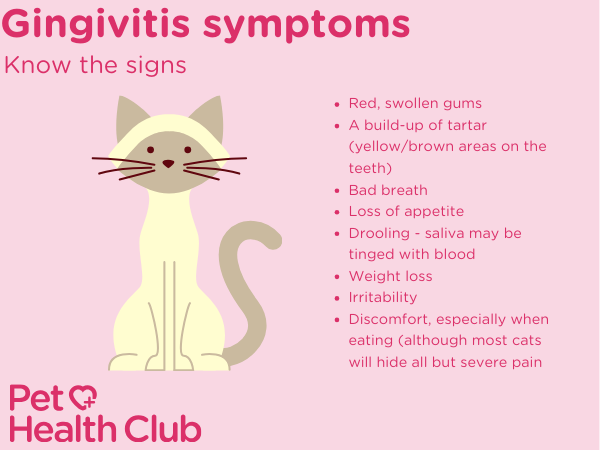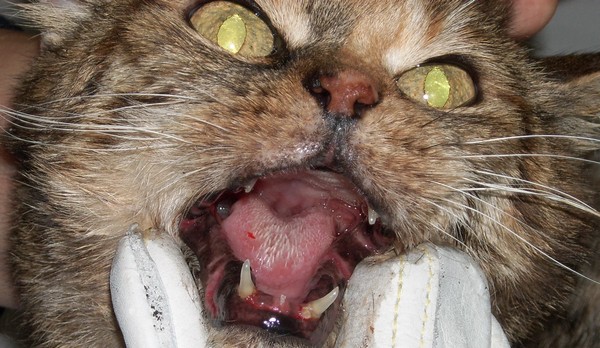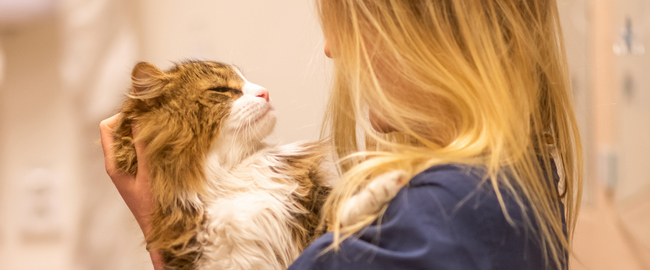Gingivitis in cats & how to keep your cat’s teeth and gums healthy
What is gingivitis? To begin with, the suffix ‘itis’ means inflammation, so gingivitis is simply inflammation of the gingiva — the gum pockets that hold the teeth securely in place. Gingivitis in cats is a painful condition with many possible causes.
The condition can spread to other parts of the mouth (stomatitis), making eating very uncomfortable and sore for your cat, so getting treatment fast is important. If gingivitis is left untreated, it can progress to tooth loss due to periodontal disease, also known as periodontitis.
According to a study, 1.8 million cats in the UK are diagnosed with periodontal disease every year, meaning it’s the most commonly diagnosed disease in cats in the UK.
Summary of gingivitis in cats
- Gingivitis in cats is gum inflammation caused by plaque and bacteria and can be related to other health issues.
- It can lead to pain and feeding problems
- Look for symptoms like swollen gums, bad breath, and weight loss
- Early treatment is crucial and includes dental cleaning and addressing underlying conditions
- Good dental hygiene prevents complications, and home care involves brushing and using vet-approved dental products
- Untreated gingivitis can progress to periodontitis, risking tooth loss
Causes of gingivitis in cats
The most common cause of gingivitis in cats is poor oral hygiene, leading to a build-up of plaque and bacteria. Other causes include:
- Bartonella bacteria
- Feline immunodeficiency virus (FIV)
- Feline calicivirus (FCV)
- Feline leukaemia virus (FeLV)
- Kidney disease
- A low-fibre diet
Spotting the symptoms of gingivitis in cats
The signs and symptoms of gingivitis in cats include:
- Red, swollen gums
- Build-up of tartar (yellow/brown areas on the teeth)
- Bad breath
- Loss of appetite
- Drooling - saliva may be tinged with blood
- Weight loss
- Irritability
- Discomfort, especially when eating (although most cats will hide all but severe pain)

Treatment of gingivitis has a far greater chance of success when the condition is caught early.
Is gingivitis in cats painful?
Yes, gingivitis in cats can be painful and lead to discomfort, pain and even difficulty eating for your cat.
If your cat has gingivitis, they may show signs of discomfort while eating, paw at their mouth or shake their head frequently, and may be less inclined to chew on toys or food due to the pain.
In severe cases, it can cause behavioural problems because of the pain, making your cat more irritable, aggressive and introverted.

Treating gingivitis in cats
Treatment for gingivitis involves cleaning the teeth using an ultrasonic scaler to remove the build-up of plaque and tartar – much like a dental hygienist appointment. Your vet may also polish your cat’s teeth, which helps to prevent the plaque from returning.
Before cleaning your cat’s teeth, your vet may prescribe appropriate pain relief or antibiotics to temporarily control any inflammation in your cat’s mouth.
If your veterinarian spots the signs of any underlying conditions, such as feline leukaemia virus (FeLV), feline immunodeficiency virus (FIV), or feline calicivirus (FCV), they may suggest the appropriate tests. In that case, they will talk to you about the management or treatment of the condition.
If there is no underlying cause, your vet will recommend a thorough annual cleaning of your cat’s teeth and regular brushing at home. See our article for tips on keeping your cat’s teeth clean.
How to treat gingivitis in cats at home
Preventing or treating gingivitis in cats at home is about keeping their mouth and teeth in good shape, which can help stop their gums from being sore and swollen. There are numerous ways you can do this.
Brush their teeth
Start slowly and use a toothbrush and toothpaste made specially for cats. Getting your cat comfortable brushing their teeth can take time, so it’s best to start when they’re a kitten, although it’s never too late to start. Keep sessions short to start with, and give plenty of praise.
Dental diets and treats
Some food and treats are designed to help clean your cat's teeth as they eat. Look for products that are made to support dental health. They can help reduce plaque and tartar buildup.
Dental toys
Some toys help clean their teeth while playing. These help your cat stay active and clean their teeth at the same time.
Regular check-ups
Even with home care, having your cat's teeth checked regularly by a vet is important. They can spot signs of gingivitis or other dental problems early on and recommend treatment. Pet Health Club members receive six-monthly check-ups and 10% off dental procedures as part of their membership benefits.
If your cat's gingivitis doesn't get better with home care, or their gums are red, swollen, or bleeding, visit your vet. They can offer more treatments and help get your cat's dental health back on track.
Periodontitis
Ensuring that your cat is treated quickly for gingivitis is important because, if left untreated, it can lead to periodontitis. Periodontitis is where the small tissues that attach your cat’s teeth to the gums and bone begin to be attacked by disease-causing bacteria. They will soon become inflamed and dissolve the bone, causing pain and tooth loss.
Most cats with periodontitis will show signs of gingivitis, as gingivitis always comes first. However, other signs may include:
- Drooling
- Bad breath
- Turning their head to eat
- Refusing food
- Tooth loss
- Exposure of the tooth root
To assess your cat and diagnose periodontitis properly, your vet will x-ray the head and jaw and thoroughly probe your cat’s teeth. Because of the difficulty and discomfort that comes from this, your cat will need to have a general anaesthetic.
Treatment of peritonitis will often include the removal of plaque, but in most cases, it means removing one or more teeth.
Is gingivitis contagious in cats?
No, gingivitis isn’t contagious between cats. However, even though the condition isn't directly passed from one cat to another, poor dental hygiene in a household of cats can raise the chances of multiple cats developing dental issues.
Any studies into gingivitis in cats?
A study by the Royal Veterinary College (RVC) has looked into periodontal disease in cats. The study found that:
- 15.2% of cats in the UK are diagnosed with periodontal disease each year
- Certain breeds like Siamese, Maine Coon, and British Short Hair, as well as crossbreeds, are more likely to be diagnosed
- The risk of periodontal disease increases with age, particularly in cats aged 9 to 12 years, who are 6.7 times more likely to suffer from the condition than younger cats
- Cats with periodontal disease are also at a higher risk of other health problems, including cardiac dysrhythmia and ear infections
This research shows how important dental care is for cats, especially as they age. Prevention, such as regular tooth brushing and dental checks, can significantly help manage the disease. Establishing a routine for your cat's dental care can help keep them healthy and happy.
Want advice on gingivitis in cats?
In case of severe pain, sudden worsening of symptoms, or any emergency, you must contact your vet immediately for prompt evaluation and treatment. Make an appointment with your vet for advice on cat gingivitis and other gum health issues.
Find your nearest vet using our find a vet page, or speak to a vet online using our video vets service.


